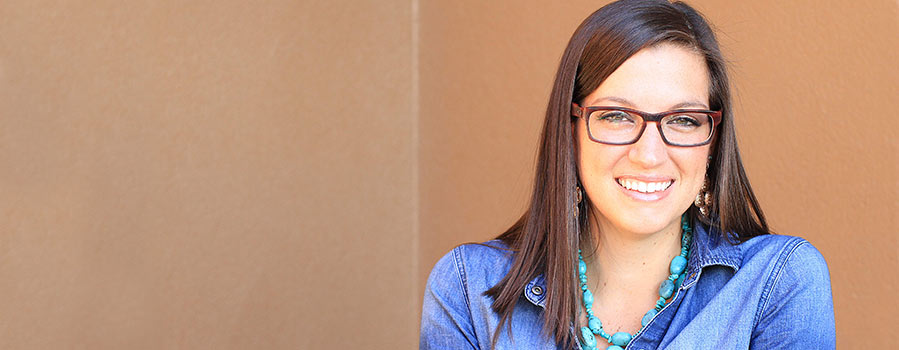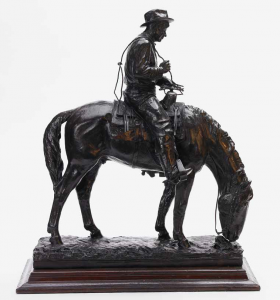
Dr. Adrienne Keene
Dr. Keene is currently a postdoctoral fellow at Brown University’s Center for Race and Ethnicity. She is a 2014 EdD graduate from the Harvard Graduate School of Education. Her research focuses on college access for Native American students. She also writes a blog called Native Appropriations focusing on representations of Native peoples which has received national and international attention. She is a member of the Cherokee Nation of Oklahoma. Check out Adrienne’s blog here: http://nativeappropriations.com
What are your thoughts on the portrayals of Native Americans in western American art?
In the genre of western art there tends to be very narrow portrayals of Native peoples. There is not a lot of diversity in the communities represented, and the images play into a very romanticized version of Native America. There are Edward Curtis-esque images of Natives as static and unchanging, stuck in the past, always wearing traditional regalia, and as part of the broad untouched western landscape. This of course is problematic in a lot of ways because it relegates Native people to the historic past and doesn’t acknowledge our ongoing existence and contemporary communities and cultures.
What is the relationship between historical images of Native Americans and current cultural appropriations?
For many people the only images they see of Native peoples are very narrow stereotypes that become representative of “real Indians,” and therefore authenticity. When we want our contemporary issues to be acknowledged, as well as our triumphs and successes, most people don’t even realize that we exist because they are only exposed to these romanticized historical images. They don’t see us as real modern people because we don’t exist in that original form folks were looking at in the 1800s, and those images play into that. But of course our communities still exist and culture is a very non-static, changing thing.
What can we learn from western American art?
There is a lot of value in looking at the way Native peoples are portrayed, offering a critical lens on it, and being able to understand the roots of where these images come from because, like I said before, I see it as parallel to a lot of contemporary relationships. When we are looking at the ways these non-Native artists are portraying Native peoples, it is a reflection of the ways that Native peoples are situated in society. This art reflects a sense of imperialist nostalgia. The position of Native people is a direct result of ongoing colonization and colonialism in America, yet there is this longing for what the Native was before contact, the freedom unconstrained by the bounds of society sort of stuff. It is powerful to think about those continued relationships and to be able to see them reflected in this art.
How can we address the inaccurate images in our collection?
The biggest thing is providing context. What was going on at the time that these paintings and sculptures were being created? What was the national narrative at the time? What may have influenced the artist’s perception of Native peoples? Also, including contemporary Native voices is the biggest thing that is often overlooked in galleries and museums. Even if you are looking at historic pieces, make sure that the audience leaves with an understanding of contemporary communities as well. Allow Native people to speak back to the pieces or show other contemporary art that can offer different perspectives. Giving a historic image context changes it from being a representation that is widely accepted to one that doesn’t have to be the sole narrative.
How do stereotypes impact Native artists?
As an undergrad, I was really interested in Native art and representations in museum contexts. I looked at the ways that outside Western influences shape what is seen as authentic in both Native art and also in artist identity. A lot of Native artists I researched felt pressured to make their work look Indian, whatever that means. In a tongue-in-cheek play called Tall Visitor at the Indian Gallery, or the Future of Indian Art, Rennard Strickland wrote about these white folks going through a Native gallery and breathlessly counting the number of triangles that could be construed as tipis in an abstract piece to mark it as Indian. I thought that was a great image. A lot of non-Native consumers are really trying to find what it is about a piece of art that makes it Native and in doing that they tend to fall back on a lot of stereotypes. Whereas a non-Native artist can paint whatever they want in whatever style they want, folks are still looking for those markers that make things identifiably Indian, and those markers tend to come from outsider perceptions, not from Native communities at all.
 What are your thoughts on our portrait of Will Rogers by Sally Farnham?
What are your thoughts on our portrait of Will Rogers by Sally Farnham?
In Oklahoma, Will Rogers is an absolute hero. He did a lot of good for Indian Country in terms of awareness. He was able to gain mainstream acceptance while also being vocal about his Cherokee heritage, but he was also a product of the beliefs about Native people at the time. He was breaking stereotypes in being the cowboy, but still played into some of those stereotypes because that was the only way he could be recognized as a Native person. That is something that really goes through a lot of our history, and even still goes on today. I think it is powerful to include an image of Will Rogers. That piece offers an interesting counterpoint to the other images.
What do you want people to know about Native American cultures?
The biggest thing I want people to take away is that there is not one Native American culture. Northwest Coast art is very different from Plains art which is very different from Southeastern art, and the communities that create the art are very different as well. Each of us has our own histories, stories, languages, and more. Also just recognizing that there is a lot of vibrancy and success and joy in contemporary Native communities. There tends to be a focus on the challenges and on the painful parts of history. These are very important to acknowledge but I feel like we also need to acknowledge the amazing things that are happening in Indian Country, like Matika Wilbur’s Project 562, or the work Jessica R. Metcalfe is doing with Beyond Buckskin Boutique and the Native fashion movement. There are a lot of really powerful, bright, and exciting things happening, I could go on for a long time.
Image credits (top to bottom): Image of Dr. Adrienne Keene by Matika Wilbur, 2015. Courtesy of the artist. Sally James Farnham (American, 1869-1943), Will Rogers on Horseback, circa 1938. Bronze, 21 ½ í— 17 ½ í— 5 ½ inches. Tacoma Art Museum, Haub Family Collection, Gift of Erivan and Helga Haub.